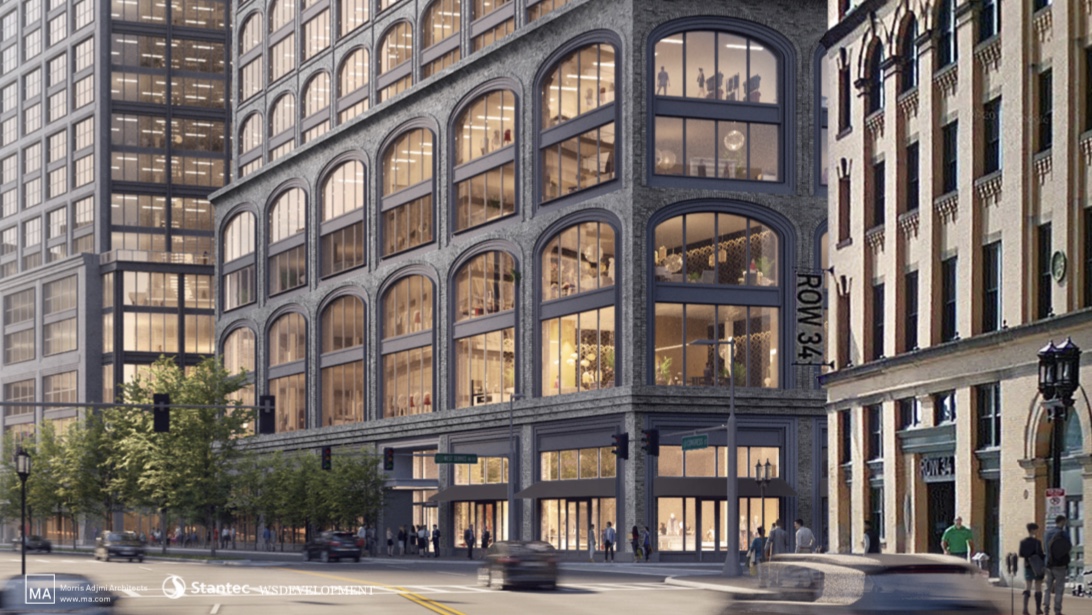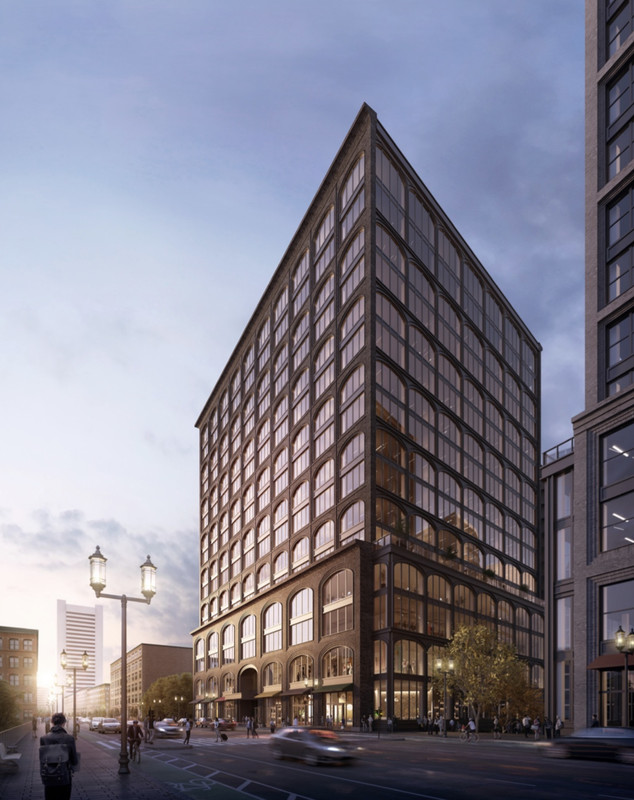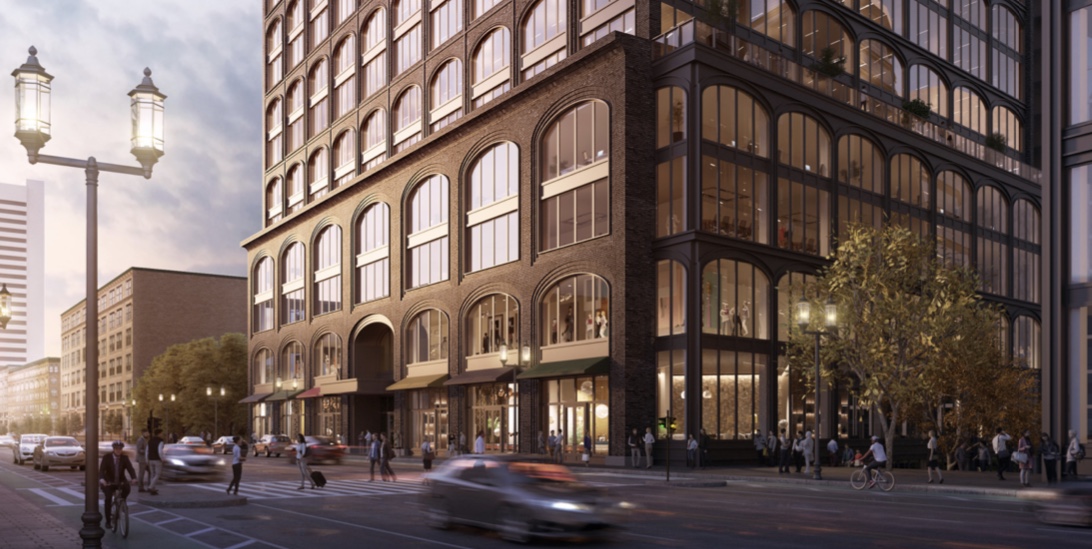I appreciate the wallpaper comment. Made me chuckle. (It's the very same comment many of us made when Johnson's IP went up.) Maybe I'll agree when I see "N" in the flesh, and maybe not? Right now I disagree. I like what I see. Or maybe I'm simply relieved something different is going up. That would be a terrible admission but look around. I'd take more "mistakes" like this than most of what is going up in our beautiful city. No matter one's taste, refined or common-place, i think many Bostonians would agree.
You are using an out of date browser. It may not display this or other websites correctly.
You should upgrade or use an alternative browser.
You should upgrade or use an alternative browser.
Seaport Sq. Block N | 350 Summer Street | Seaport
- Thread starter Equilibria
- Start date
odurandina
Senior Member
- Joined
- Dec 1, 2015
- Messages
- 5,328
- Reaction score
- 265
The Seaport's faux-pas uppity-class, politically incorrect, banal, not quite ready for prime time, poser-glitter, post-modern/gilded age, mid-rise canyon, presents fully exposed, refreshing colon cleanse quite-more-honest than Beacon Hill, Back Bay, and 1/2 the rest of Boston. Thank you Tom Menino/Marty Walsh/ BRA. Generally, the more they hate the Seaport--the more i love it.
This: much less to hate.
This: much less to hate.
(how i learned to stop worrying and love the delightfully tacky Seaport).
Last edited:
whighlander
Senior Member
- Joined
- Aug 14, 2006
- Messages
- 7,812
- Reaction score
- 647
Stick -- Oh Yes they couldThe podiums are perfect here. They are the same height as their Fort Point neighbors, allowing a continuation of the street wall from Fort Point on through the new development.
From Congress st the roof line of the building on the right continues seamlessly through both new podiums. Even the round windows and first floor floor beam are a nod between these two.
The way the street wall visually rounds the corner is wonderful.
Even Summer st, something I never thought Id see..
The podium cornice visually mates right up to the next building down.
^Theres also still an empty lot to the right of that building in Fort Point where those trees are that when developed will close the gap even more.
This is going to be absolutely amazing when completed and Im grateful that this is the direction they went here. This is one of those rare examples where they couldnt have done better.
This is a huge outbreak of PFAUX-Palladionism
Palladio reserved the Palladio windows for where they were important to the overall structure -- this is just a simple algorithm done on a 3D printer -- design one pseudo Palladian window bay and then repeat endlessly until the entire facade is so covered
When I saw the first render -- I liked it because of the somewhat superficial attempt at contexualism -- but then on closer review -- NO -- Too Much!
This is not a Post Great Fire Masonry structure or even early 20th C steel with real masonry exterior wall -- this is a Post Millennium Steel Frame with a [Chose one from the pull-down menu: curtain wall] hung on the steel like a copy of a famous painting hanging on a wall of a house in the suburbs*1
How about leaving the podium as it is -- pseudo contextualist with Summer St.-- and then the rest of the building be contextual with the rest of the Seaport -- glass and steel curtainwall
*1
Full disclosure -- I have a very nice copy of the painting by Fitz Hugh Lane*2 of Boston Harbor -- the original is in the American Wing of the MFA -- mine surmounts my fireplace mantelpiece [almost full sized and very luminous]
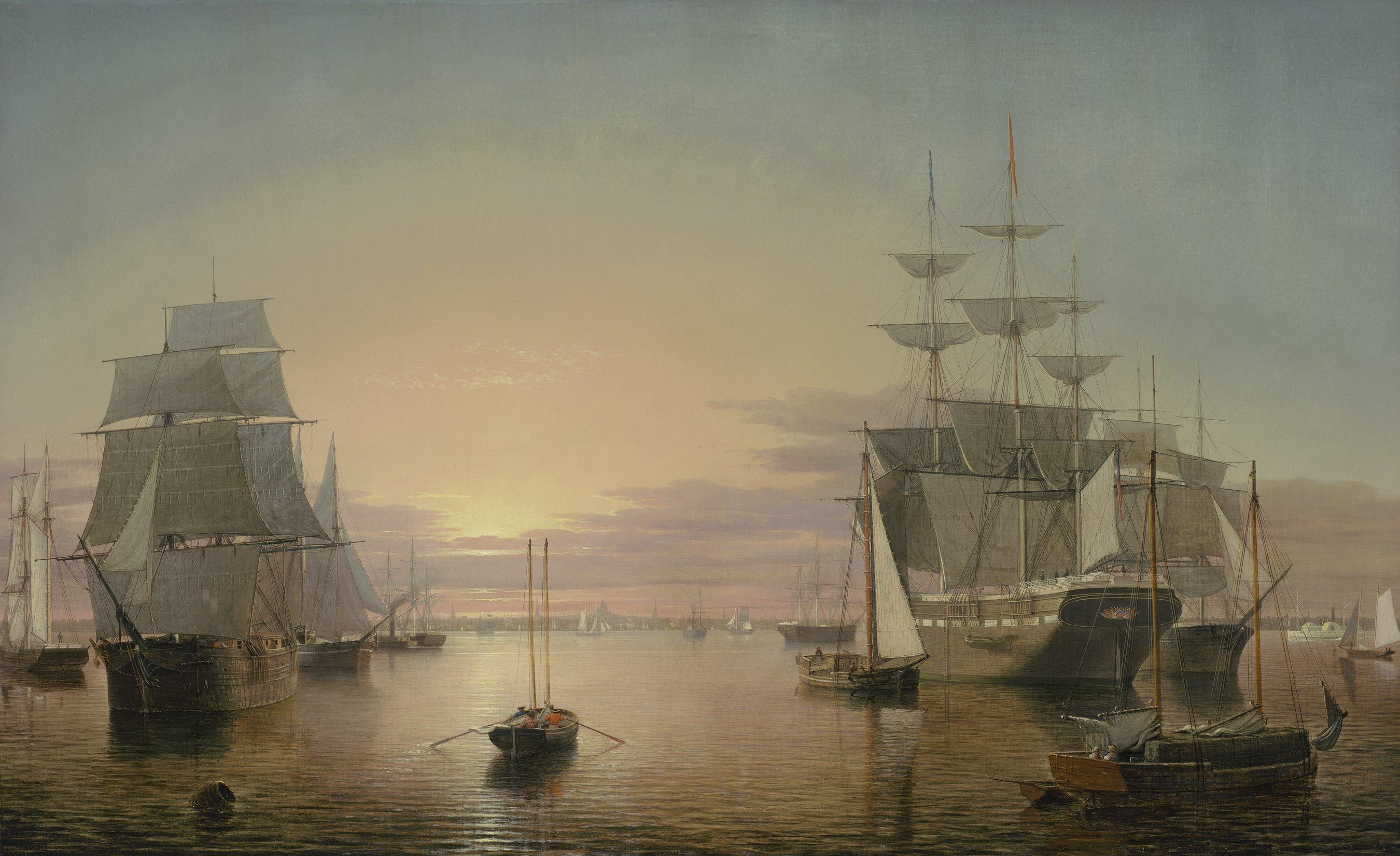
Fitz Henry Lane (born Nathaniel Rogers Lane, also known as Fitz Hugh Lane) (19 December 1804 - 14 August 1865) was an American painter and printmaker of a style that would later be called Luminism, for its use of pervasive light. Fitz Henry Lane was born on December 19, 1804, in Gloucester, Massachusetts.
Boston Harbor – Works – Museum of Fine Arts, Boston
collections.mfa.org
Gloucester, Massachusetts, native Fitz Henry Lane was at the height of his career by 1850, when he executed this grand and tranquil scene of the bustling port of Boston. From the vantage of a hill in East Boston, a perspective popularized in printed views of the city, Lane suggests topographical accuracy in his carefully constructed scene of vessels dispersed before the horizon. Prominent features of the city such as the Massachusetts State House and the Old South Church are clearly visible, but Lane lowered the horizon line to convey a sense of the expansive harbor.
- Joined
- Jan 22, 2012
- Messages
- 5,078
- Reaction score
- 1,661
^ Weird flex, but okay.
stick n move
Superstar
- Joined
- Oct 14, 2009
- Messages
- 12,041
- Reaction score
- 18,708
I actually think the arches were more of a nod to its immediate neighbors in Fort Point which have curved window arches rather than just a random idea.
I had outlined the curves on the shorter buildings at first, but it was too much drawing on the render, so I cleaned it up and just posted this. I think though that not only does the roof and first floor beam line up here, as outlined, but the arches are also borrowed as well as a nod to its neighbor. The building on the left also has 3 different rows of arched windows. Thats why I think its a tasteful addition and continuation of Fort Point and not just a random architectural touch.
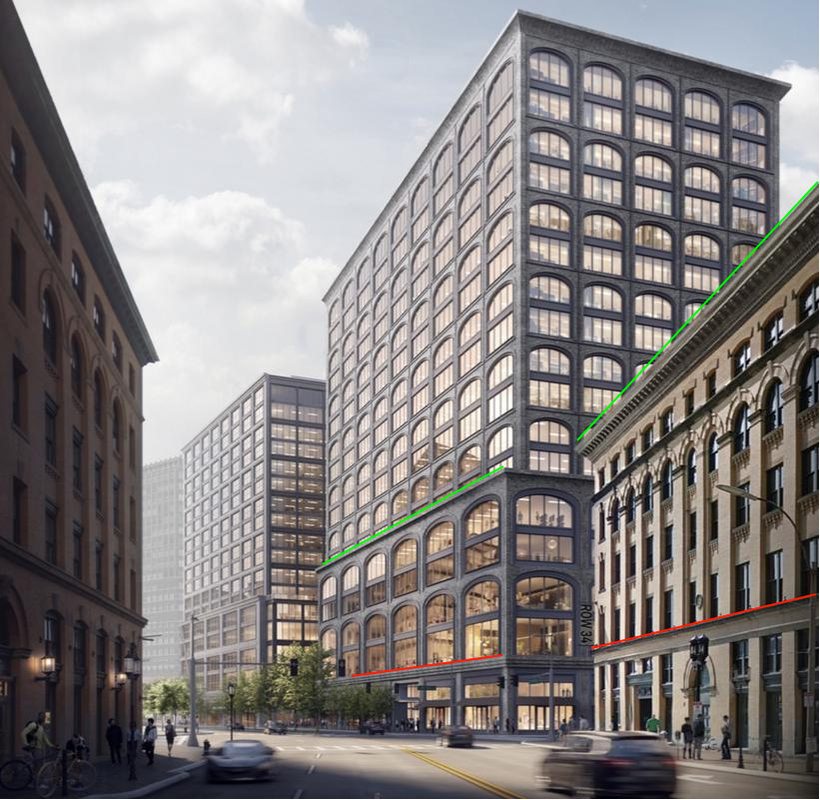
I thought about this too and this would have also been contextual, but that style is used mostly when adding a tower above an existing base. It would have worked, but I think that this does too. I like this more in this spot because that scenario would have added yet another glass box to the seaport from the base up. I like that this is something different and refreshing. Not everybody is going to like it, as with anything else, but in my opinion both of these new buildings are great.
I had outlined the curves on the shorter buildings at first, but it was too much drawing on the render, so I cleaned it up and just posted this. I think though that not only does the roof and first floor beam line up here, as outlined, but the arches are also borrowed as well as a nod to its neighbor. The building on the left also has 3 different rows of arched windows. Thats why I think its a tasteful addition and continuation of Fort Point and not just a random architectural touch.

How about leaving the podium as it is -- pseudo contextualist with Summer St.-- and then the rest of the building be contextual with the rest of the Seaport -- glass and steel curtainwall
I thought about this too and this would have also been contextual, but that style is used mostly when adding a tower above an existing base. It would have worked, but I think that this does too. I like this more in this spot because that scenario would have added yet another glass box to the seaport from the base up. I like that this is something different and refreshing. Not everybody is going to like it, as with anything else, but in my opinion both of these new buildings are great.
Last edited:
Equilibria
Senior Member
- Joined
- May 6, 2007
- Messages
- 7,077
- Reaction score
- 8,299
Massachoicetts
Active Member
- Joined
- Jun 4, 2019
- Messages
- 573
- Reaction score
- 713
Absolutely stunning!
Wow. This is amazing.
Also... page 21 has some real beauties on it.
odurandina
Senior Member
- Joined
- Dec 1, 2015
- Messages
- 5,328
- Reaction score
- 265
Interesting they brought up 134 Wooster.
I was thinking 264' should usually default to glass.
This one has me doubting the premise.
I was thinking 264' should usually default to glass.
This one has me doubting the premise.
I believe these two buildings will do so much to connect the upper and lower neighborhoods, both visually and physically with the stairs. The designs are also a great transition between the prevailing architecture along the Summer Street corridor and the Seaport.
stick n move
Superstar
- Joined
- Oct 14, 2009
- Messages
- 12,041
- Reaction score
- 18,708
Plus with omni Summer st is actually going to have a street wall finally, a high quality one too. Its always felt like you were up above the Seaport looking down, so itll be nice for it to really feel like a part of it now.
stellarfun
Senior Member
- Joined
- Dec 28, 2006
- Messages
- 5,711
- Reaction score
- 1,544
From looking at Moris Adjmi's portfolio, this is their first project in New England. Most of their work is in New York City.
I think the arch and the palette takes a bit of a cue from Adjaye's 130 William in NYC. Though 130 William is textured concrete.
:format(webp)/cdn.vox-cdn.com/uploads/chorus_image/image/61733717/2018_10_10_130_William_DSC09290.0.jpg)
I think the arch and the palette takes a bit of a cue from Adjaye's 130 William in NYC. Though 130 William is textured concrete.
:format(webp)/cdn.vox-cdn.com/uploads/chorus_image/image/61733717/2018_10_10_130_William_DSC09290.0.jpg)
^^ Adjmi's been doing these types of designs in NYC since long before David Adjaye was invited to bid on anything.
Adjmi IMO is a much better architect than the massively over-rated Adjaye. And I greatly prefer Adjmi's various (relatively small, low-fanfare) buildings in NYC to Adjaye's 130 William, which both obliterated what had been a tight streetwall of various 100-year-old-plus tenement facades for the sake of an inset, port cochere-looking ground floor, and at the end of the day looks like a brutalist eyesore thrust 800 feet into the air. Just look at Adjaye's completed NYC building, on 155th Street, or his design for the upcoming Studio Museum of Harlem. They both look identical to each other, and their designs are best described as, "Buzz ... your girlfriend ... woof!"
Adjmi IMO is a much better architect than the massively over-rated Adjaye. And I greatly prefer Adjmi's various (relatively small, low-fanfare) buildings in NYC to Adjaye's 130 William, which both obliterated what had been a tight streetwall of various 100-year-old-plus tenement facades for the sake of an inset, port cochere-looking ground floor, and at the end of the day looks like a brutalist eyesore thrust 800 feet into the air. Just look at Adjaye's completed NYC building, on 155th Street, or his design for the upcoming Studio Museum of Harlem. They both look identical to each other, and their designs are best described as, "Buzz ... your girlfriend ... woof!"
Equilibria
Senior Member
- Joined
- May 6, 2007
- Messages
- 7,077
- Reaction score
- 8,299
BCDC:
Not that it ruins it or anything, but the dark metal was much better. The light metal contributes to the colossal order by hiding the distinctions between floors, and actually makes the building look less timeless.
Don't know what kind of hacks they have on the BCDC these days...
Not that it ruins it or anything, but the dark metal was much better. The light metal contributes to the colossal order by hiding the distinctions between floors, and actually makes the building look less timeless.
Don't know what kind of hacks they have on the BCDC these days...
stick n move
Superstar
- Joined
- Oct 14, 2009
- Messages
- 12,041
- Reaction score
- 18,708
Yup thats worse

